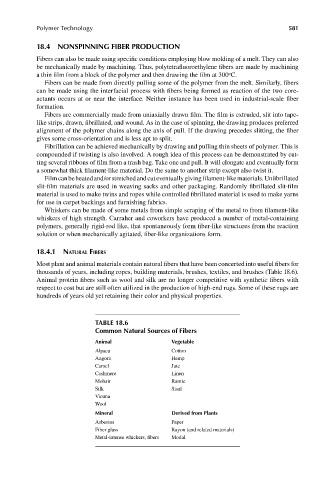Page 618 - Carrahers_Polymer_Chemistry,_Eighth_Edition
P. 618
Polymer Technology 581
18.4 NONSPINNING FIBER PRODUCTION
Fibers can also be made using specific conditions employing blow molding of a melt. They can also
be mechanically made by machining. Thus, polytetrafl uoroethylene fibers are made by machining
o
a thin film from a block of the polymer and then drawing the film at 300 C.
Fibers can be made from directly pulling some of the polymer from the melt. Similarly, fi bers
can be made using the interfacial process with fibers being formed as reaction of the two core-
actants occurs at or near the interface. Neither instance has been used in industrial-scale fi ber
formation.
Fibers are commercially made from uniaxially drawn fi lm. The fi lm is extruded, slit into tape-
like strips, drawn, fibrillated, and wound. As in the case of spinning, the drawing produces preferred
alignment of the polymer chains along the axis of pull. If the drawing precedes slitting, the fi ber
gives some cross-orientation and is less apt to split.
Fibrillation can be achieved mechanically by drawing and pulling thin sheets of polymer. This is
compounded if twisting is also involved. A rough idea of this process can be demonstrated by cut-
ting several ribbons of film from a trash bag. Take one and pull. It will elongate and eventually form
a somewhat thick filament-like material. Do the same to another strip except also twist it.
Film can be heated and/or stretched and cut eventually giving filament-like materials. Unfi brillated
slit-film materials are used in weaving sacks and other packaging. Randomly fi brillated slit-fi lm
material is used to make twins and ropes while controlled fibrillated material is used to make yarns
for use in carpet backings and furnishing fabrics.
Whiskers can be made of some metals from simple scraping of the metal to from fi lament-like
whiskers of high strength. Carraher and coworkers have produced a number of metal-containing
polymers, generally rigid-rod like, that spontaneously form fiber-like structures from the reaction
solution or when mechanically agitated, fiber-like organizations form.
18.4.1 NATURAL FIBERS
Most plant and animal materials contain natural fibers that have been concerted into useful fi bers for
thousands of years, including ropes, building materials, brushes, textiles, and brushes (Table 18.6).
Animal protein fibers such as wool and silk are no longer competitive with synthetic fi bers with
respect to cost but are still often utilized in the production of high-end rugs. Some of these rugs are
hundreds of years old yet retaining their color and physical properties.
TABLE 18.6
Common Natural Sources of Fibers
Animal Vegetable
Alpaca Cotton
Angora Hemp
Camel Jute
Cashmere Linen
Mohair Ramie
Silk Sisal
Vicuna
Wool
Mineral Derived from Plants
Asbestos Paper
Fiber glass Rayon (and related materials)
Metal-intense whickers, fi bers Modal
9/14/2010 3:43:37 PM
K10478.indb 581 9/14/2010 3:43:37 PM
K10478.indb 581

